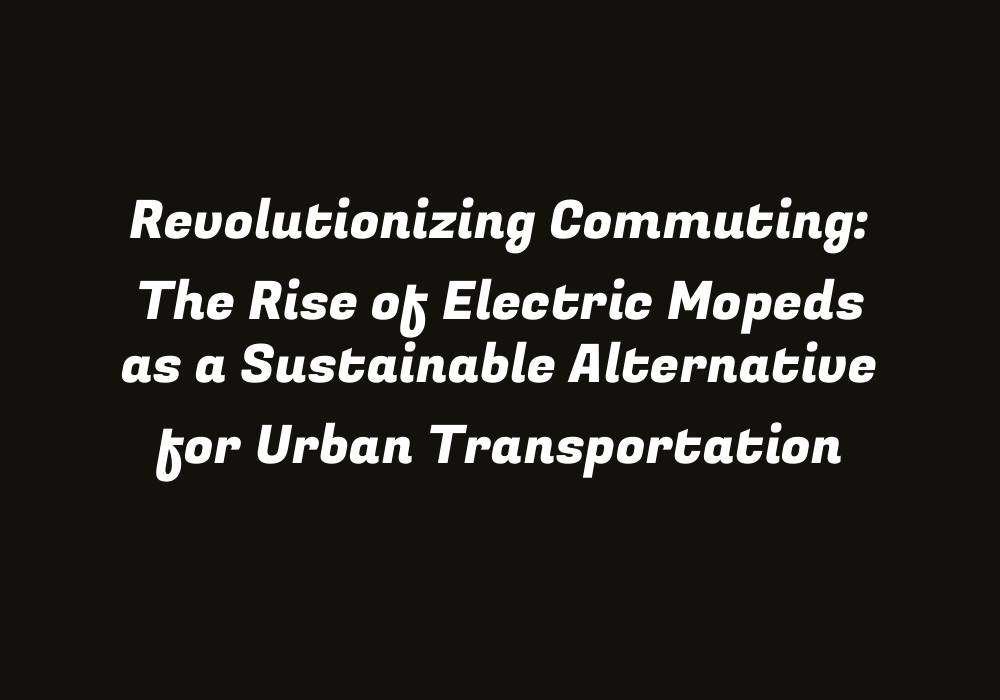Introduction to Electric Mopeds: The Future of Urban Transportation
With the increasing global population, there has been a rise in demand for efficient, sustainable transportation methods that cater to the needs of urban commuters. The search for more eco-friendly and cost-effective alternatives has led to an upsurge in popularity for electric mopeds as a promising solution to urban congestion issues. This article delves into the revolutionizing potential of these environmentally friendly vehicles and how they can become the new standard for efficient, sustainable urban transportation.
Electric Mopeds: An Overview
Electric mopeds are a form of light electric vehicle (LEV) characterized by their two or three-wheeled design and low-power motorized propulsion systems. These vehicles are primarily powered by electric batteries, which enable them to run silently without emitting exhaust fumes. The main components include an electric motor, battery pack, and a controller. They can be further categorized into different types based on their power output, weight, and intended use.
Benefits of Electric Mopeds
There are several reasons why electric mopeds have gained significant attention as a sustainable alternative to traditional modes of urban transportation. They provide numerous benefits that cater to the needs of both individual commuters and society at large. Here is an overview of their primary advantages:
1. Eco-Friendly: The most apparent benefit is their environmental impact compared to gasoline-powered vehicles. Electric mopeds produce zero emissions, helping reduce air pollution and its associated health risks.
2. Cost Savings: With electric power comes reduced operational expenses. Electric mopeds do not require fueling and have lower maintenance costs than their gas-guzzling counterparts. As a result, they are more affordable to operate in the long run.
3. Energy Efficiency: The energy consumption of electric mopeds is considerably lower compared to traditional vehicles due to their efficient motors and batteries. This translates to better energy efficiency and reduced reliance on fossil fuels.
4. Space-Efficient: Electric mopeds take up less parking space, making them ideal for densely populated urban areas where parking is at a premium. They can also be easily stored in small spaces like garages or apartments without occupying much area.
5. Easy Handling: With their smaller size and lighter weight compared to motorcycles and scooters, electric mopeds are easier to maneuver through congested urban areas. This makes them suitable for both first-time riders and seasoned commuters alike.
6. Accessibility: Electric mopeds offer a more inclusive transportation option by providing access to people with disabilities or limited mobility who might otherwise struggle with traditional bikes or scooters. Their electric motor can help compensate for any physical limitations, allowing individuals greater independence in their daily commutes.
Addressing Concerns and Barriers
While electric mopeds hold great potential as a sustainable alternative to conventional modes of transportation, there are certain challenges that must be addressed to ensure widespread adoption. These include:
1. Regulatory Framework: There is a lack of uniform legislation governing the use of electric mopeds in various countries and cities. Clear guidelines need to be established to promote safe usage while fostering acceptance among the public.
2. Battery Technology Advancements: Continuous improvements in battery technology are crucial to extending the range, charging time, and overall efficiency of electric mopeds. This would enhance their practicality and appeal for commuters.
3. Infrastructure Development: The widespread adoption of electric vehicles requires a well-integrated infrastructure that supports charging stations, secure parking facilities, and dedicated lanes for sustainable transportation modes.
4. Education and Awareness: Raising public awareness about the environmental benefits and practical advantages of electric mopeds can help foster greater acceptance among potential users. This will play a significant role in encouraging more people to adopt these vehicles as their primary mode of transport.
Conclusion
As urban populations continue to grow, it is essential to find innovative solutions that cater to the needs of the modern commuter while addressing environmental concerns. Electric mopeds represent a viable option for sustainable urban transportation, offering numerous benefits that contribute to cleaner air and reduced reliance on fossil fuels. By overcoming existing challenges and continuing to develop this exciting technology, electric mopeds can usher in a new era of efficient and eco-friendly urban commuting, ultimately revolutionizing the way we move around cities.
